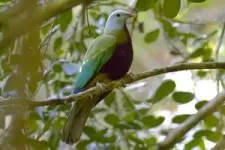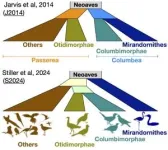Golfers’ risk from pesticides used on turfgrass is likely low, studies find
2024-04-01
(Press-News.org) For many, spring heralds fresh air and exercise on the golf course. But do players risk exposure to unsafe levels of pesticides used to beautify and maintain a golf course’s green grass? To find out, researchers asked volunteers to play 18 holes on a simulated course sprayed with common pesticides. They report the results in ACS Agricultural Science & Technology, saying there is likely limited cause for concern over toxic exposure from pesticide-treated turf.
There are plenty of studies on pesticide exposure among people who tend and harvest crops grown in treated environments. But John M. Clark and colleagues couldn’t find much comparable information about individuals who play sports, including soccer and golf, in the great outdoors. So, his team designed a study to investigate golfers’ potential risks from four pesticides, which have low volatilities and relatively low toxicities for humans, and are commonly used on golf course turfgrass: cyfluthrin (insecticide), chlorothalonil (fungicide), MCPP-p (herbicide) and 2,4-D (herbicide).
For the study, the researchers created what they deemed a “worst-case-scenario” 18-hole course: All areas of a simulated golf course were treated with the manufacturers’ suggested maximum amount of all four pesticides. Then they recruited eight volunteer golfers to play a full round on the treated turf one hour after pesticide application and to remain on the course for four hours. To measure pesticide exposure, four of the volunteers wore cotton full-body suits with veils, socks and gloves that would pick up contact residues and personal air samplers that would capture airborne residues. The other four volunteers wore cut-off cotton suits over their own golfing clothes and submitted urine samples after the round.
After the volunteers finished golfing, Clark’s team measured pesticide residues on the dosimetry suits and air samplers and found that the hand and lower leg segments picked up the most residue while airborne residues contributed little to exposure. The researchers also measured the volunteers’ exposure risk from the levels of pesticides found on the suits and in the urine samples by calculating the hazard quotient (HQ). The team found that the HQ values from the golfers’ exposure indicated little risk to the four pesticides used in this study.
Finally, Clark and colleagues compared the insecticide cyfluthrin results to their 2008 Journal of Agricultural and Food Chemistry study with older, neurotoxic insecticides at the same simulated golf course site — and using the same protocols. Both studies’ HQ values were well below 1.0, the level that indicates potentially unsafe exposure. However, in the prior work, the volunteers’ urinalysis HQ values of 0.0318 and 0.054 for chlorpyrifos and carbaryl, respectively, were an order of magnitude greater than the volunteers’ urinalysis HQ of 0.0043 from this 2024 study with the insecticide cyfluthrin. The researchers say this comparison shows the potential benefit of using modern, lower volatility and less toxic pesticides, which could further reduce golfers’ risk of adverse effects from exposure.
The authors acknowledge funding from the United States Golf Association and the New England Regional Turf Foundation.
###
The American Chemical Society (ACS) is a nonprofit organization chartered by the U.S. Congress. ACS’ mission is to advance the broader chemistry enterprise and its practitioners for the benefit of Earth and all its people. The Society is a global leader in promoting excellence in science education and providing access to chemistry-related information and research through its multiple research solutions, peer-reviewed journals, scientific conferences, eBooks and weekly news periodical Chemical & Engineering News. ACS journals are among the most cited, most trusted and most read within the scientific literature; however, ACS itself does not conduct chemical research. As a leader in scientific information solutions, its CAS division partners with global innovators to accelerate breakthroughs by curating, connecting and analyzing the world’s scientific knowledge. ACS’ main offices are in Washington, D.C., and Columbus, Ohio.
To automatically receive news releases from the American Chemical Society, contact newsroom@acs.org.
Note: ACS does not conduct research, but publishes and publicizes peer-reviewed scientific studies.
Follow us: X, formerly Twitter | Facebook | LinkedIn | Instagram
END
ELSE PRESS RELEASES FROM THIS DATE:
2024-04-01
SAN ANTONIO, April 1, 2024 – Boris A. Zelle, MD, FAAOS, FAOA, professor, vice-chair of research and chief of orthopaedic trauma in the Department of Orthopaedics at The University of Texas Health Science Center at San Antonio (UT Health San Antonio), recently received the American Academy of Orthopaedic Surgeons 2024 Diversity Award, recognizing outstanding contributions to advancing diversity in the field.
With more than 39,000 members, the AAOS is the world’s largest medical association of musculoskeletal specialists.
“Receiving the AAOS Diversity Award means a lot to me,” Zelle told the AAOS. “I have practiced academic ...
2024-04-01
Scientists have been searching for the optimal coronavirus vaccine since the Covid-19 pandemic started. The mRNA vaccines developed through the federal government's "Operation Warp Speed" program were a massive innovation; however, annually updating those boosters for specific SARS-CoV-2 variants is inefficient for scientists and patients. SARS-CoV-2 is just one member of the Sarbecovirus (SARS Betacoronavirus) subfamily (others include SARS-CoV-1, which caused the 2002 SARS outbreak, as well as other viruses circulating in bats that could cause future pandemics).
Researchers at the Georgia Institute of ...
2024-04-01
ROCHESTER, Minn. — Mayo Clinic scientists have developed an immunotherapy strategy that potentially lays the groundwork for treating a spectrum of autoimmune diseases.
The new technique, detailed in a preclinical study published in Nature Biomedical Engineering, involves combining chimeric antigen receptors (CAR) with mesenchymal stromal cells (MSC), resulting in engineered stem cells known as CAR-MSCs.
“The pioneering approach shows potential in targeting inflammatory disease sites more precisely and improving immunosuppression and healing outcomes,” says Saad Kenderian, M.B., ...
2024-04-01
An enormous meteor spelled doom for most dinosaurs 65 million years ago. But not all. In the aftermath of the extinction event, birds — technically dinosaurs themselves — flourished.
Scientists have spent centuries trying to organize and sort some 10,000 species of birds into one clear family tree to understand how the last surviving dinosaurs filled the skies. Cheap DNA sequencing should have made this simple, as it has for countless other species.
But birds were prepared to deceive us.
In a pair of new research papers ...
2024-04-01
A team of scientists led by researchers at Bigelow Laboratory for Ocean Sciences have developed an innovative method to link the genetics and function of individual microbes living without oxygen deep below Earth’s surface. Measuring both of these attributes — and, more importantly, linking them together — has long been a challenge in microbiology but is critical for understanding the role of microbial communities in global processes like the carbon cycle.
The new approach, developed at Bigelow Laboratory’s Single Cell Genomics Center, enabled researchers to discover that one species of sulfate-consuming ...
2024-04-01
Scientists at Uppsala University have discovered a new class of antibiotics with potent activity against multi-drug resistant bacteria, and have shown that it cures bloodstream infections in mice. The new antibiotic class is described in an article in the scientific journal PNAS.
Antibiotics are the foundation of modern medicine and over the last century have dramatically improved the lives of people around the world. Nowadays we tend to take antibiotics for granted and rely heavily on them to treat or prevent ...
2024-04-01
Birds are the only dinosaur lineage that survived until today. About 66 million years ago at the Cretaceous–Paleogene (K–Pg) boundary, a mass extinction event destroyed all non-avian dinosaurs, providing an opportunity for birds to diversify rapidly and occupy a wide range of ecological niches. Neoaves, a diverse group comprising approximately 95% of all bird species today, emerged from this radiation. From the towering condors of the Andes to the diminutive hummingbirds flitting through tropical forests, Neoaves encompass a stunning ...
2024-04-01
An international team of scientists has built the largest and most detailed bird family tree to date—an intricate chart delineating 93 million years of evolutionary relationships between 363 bird species, representing 92% of all bird families.
The advance was made possible in large part thanks to cutting-edge computational methods developed by engineers at the University of California San Diego, combined with the university’s state-of-the-art supercomputing resources at the San Diego Supercomputer Center. These technologies have enabled researchers to analyze vast amounts of genomic data with high accuracy and speed, ...
2024-04-01
TAMPA, Fla. (April 1, 2024) – The idea for Fawn Ngo’s latest research came from a television interview.
Ngo, a University of South Florida criminologist, had spoken with a Vietnamese language network in California about her interest in better understanding how people become victims of cybercrime.
Afterward, she began receiving phone calls from viewers recounting their own experiences of victimization.
“Some of the stories were unfortunate and heartbreaking,” said Ngo, an associate professor in the USF College of Behavioral and Community Sciences. “They made me wonder about the availability ...
2024-04-01
Researchers at the University of Colorado School of Medicine are hopeful new research could prevent up to 130,000 unneeded fine-needle aspiration (FNA) biopsies of thyroid nodules and subsequent surgeries each year in the United States by better understanding the genetic risk associated with thyroid cancer.
Through an R21 grant from the National Institutes of Health, Nikita Pozdeyev, MD, assistant professor of biomedical informatics, Chris Gignoux, PhD, professor of biomedical informatics, and Bryan Haugen, MD, professor of medicine and head of the Division of Endocrinology, Metabolism, and Diabetes, will study new strategies that could pave the way ...
LAST 30 PRESS RELEASES:
[Press-News.org] Golfers’ risk from pesticides used on turfgrass is likely low, studies find







